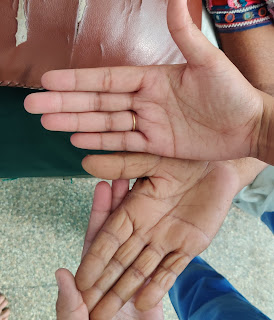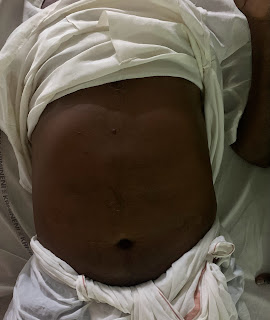MARCH EXAM
Internal assesment to the questions asked in the above blog spot.
1) Please go through the patient data in the links below and answer the following questions:
https://ashakiran923.blogspot.com/2021/03/60-years-old-male-fever-under-evaluation.html?m=1
a). What is the problem representation of this patient and what is the anatomical localization for his current problem based on the clinical findings?How specific is his dilated superficial Abdominal vein in making diagnosis?
Abdominal distension with clinical
Image of umbilicus everted : Ascitis
Decreased urine output with burning micturition : renal pathology
But is GI pathology causing renal or renal causing git or is that both are independent entities is we are not sure off.
b) What is the etiology of the current problem and how would you as a member of the treating team arrive at a diagnosis? What is the cause of his hypoalbuminemia?Why is the SAAG low?
Etiology : GIT ascitis pathology would be known by doing SAAG and his pain abdomen for any SBP and cause of hypoalbuminemia is due to either increased excretion of protein in urine responsible for renal disease nephrotic syndrome( Low saag)
Decreased synthetic function of liver
Or a long standing infectious etiology causing cachexia and hypoproteinemia.
Low saag is because the patient has exudative pathology
c)Will PT,INR derangement preceed hypoalbuminemia in liver dysfunction??Share reference articles if any
The liver plays a central role in the clotting process, and acute and chronic liver diseases are invariably associated with coagulation disorders due to multiple causes: decreased synthesis of clotting and inhibitor factors, decreased clearance of activated factors, quantitative and qualitative platelet defects, hyperfibrinolysis, and accelerated intravascular coagulation.
https://www.medscape.com/answers/177354-36077/what-is-the-role-of-prothrombin-time-pt-in-the-evaluation-of-acute-liver-failure
d)What is the etiology of his fever and pancytopenia?
1)Bone marrow tuberculosis because ascitis is low saag ( exudative : ?TB) and same tuberculus bacillus invading bone marrow
2)liver dysfunction causing haematological changes lyk anemia and thrombocytopenia
e)Can there be conditions with severe hypoalbuminemia but no pedal edema? Can one have hereditary analbuminemia and yet have minimal edema? Please go this article https://www.frontiersin.org/articles/10.3389/fgene.2019.00336/full and answer the question.
Inflammation and infection
Albumin is considered a negative acute phase reactant, which means that as inflammation and other acute physiologic processes occur, its levels decrease
In liver disease:Albumin is synthesized in the liver, and low serum albumin can be indicative of liver failure or diseases such as cirrhosis and chronic hepatitis. If present, hypoalbuminemia is generally considered to be a sign of advanced hepatic cirrhosis, or irreversible damage to the liver
Malnutrition or malabsorption
Low albumin levels can also indicate chronic malnutrition from protein losing enteropathy.[3] This is often caused or exacerbated by ulcerative colitis,[10] but can also be seen in cardiac disease and systemic lupus erythematosus.
Conditions with severe hypoalbuminemia and no pedal edema- There can be a compensatory synthesis of protiens (globulins) other than albumin and thereby maintain the oncotic pressure in the intravascular compartment and preventing the extravasation of fluid. This could also be possible if there is a hypovolemic state in the same patient with hypoalbuminemia so that the pressures are again maintained and there is no fluid accumulation.
It is possible for one with hereditary analbuminemia to not have pedal edema. Since it is a chronic and hereditary disease there can be compensatory synthesis of other plasma proteins.
f) What is the efficacy of each of the drugs listed in his current treatment plan
QUESTION 2
45year old female with abdominal distension
https://navyamallempalli.blogspot.com/2021/02/dr_6.html
a). What is the problem representation of this patient and what is the anatomical localization for her current problem based on the clinical findings?
Abdominal distension followed by pedal edema : Liver pathology
Umbilicus everted and fluid thrill : Ascites
b) What is the etiology of her refractory ascites and pleural effusion? and how would you as a member of the treating team arrive at a diagnosis?
Sodium water retention due to underfill theory
Increased portal pressure ( high SAAG) causing splanchnic vasodilation
And overfill theory is causing refractory ascites and hepatic hydrothorax is responsible for pleural effusion
c) Approach to a patient with ascites?Clinically is there any way to differentiate pre hepatic, post hepatic and hepatic causes?
Hepatic causes patient has cirrhosis of liver ( shrunken nodular on usg) with liver failure symptoms and signs splenomegaly varices
Pre hepatic : dilated veins and congenital umbilical webs
Post hepatic : raised jvp with heart failure features
d)Causes of budd chiari syndrome?Why did the patient undergo bone biopsy?
Hypercoagulable states : protein C protein S deficinency
Antithrombin 2 deficiency
Leiden mutation
Ocp intake
BCS is considered primary when obstruction of the hepatic venous outflow tract is the result of an endoluminal venous lesion (i.e., thrombus or web). BCS is considered secondary when hepatic venous outflow obstruction originates from a le- sion outside the venous system (tumor, abscess, cysts). The lesions can obstruct outflow by invad- ing the lumen or by extrinsic compression.
Patients with myeloproliferative disorders also developed budd chiari
So to look for any myeloproliferative disorders and for any bone metastasis bone biopsy was done
https://www.ncbi.nlm.nih.gov/pmc/articles/PMC4147117/
d) Management strategies for refractory ascites and Budd chiari syndrome? Share the potential advantages and disadvantages of Peritoneal dialysis catheter placement in refractory ascites?
Refractory ascitis management
1)LVP, the first-line treatment for refractory ascites, is defined as direct aspiration of >5 L of ascites.
Removal of a large volume of ascites is associated with paracentesis-induced circulatory dysfunction (PICD),7 which can be prevented by an infusion of 7–8 g of albumin per litre of fluid tapped.
2)TIPS
If four or more paracentesis procedures are performed, or paracentesis is not tolerated or contraindicated, TIPS is recommended.9 TIPS can relieve refractory ascites by directly reducing portal venous pressure.19 The most common non-surgical complication of TIPS is development of HE.
3)vasoconstrictive drugs :
Several oral drugs are available for treating refractory ascites. These drugs increase the systemic atrial volume by inducing vasoconstriction.
Midodrine,clonidine,vasopressin antagonist Tolvaptan.
4) The ALFApump is a new technology that was introduced for patients with refractory ascites in recent years. This device is subcutaneously implanted and battery-powered, and moves ascites from the peritoneal cavity to the urinary bladder to facilitate removal of fluid by urination.
5)Liver transplantation
Buddchiari treatment :
The major treatment options include an- ticoagulation, thrombolysis, percutaneous recanalization, transjugular intrahepatic portosystemic shunt (TIPS), surgery and liver transplantation.
The major indication for balloon angioplasty with or without stenting should be short segmen- tal stenosis or occlusion within the HVs and IVC.
In some experienced centers, balloon angioplasty is also employed for long segmental stenosis or occlusion within the HVs and IVC or old IVC thrombosis.
PD catheter placement for ascites drainage has many potential advantages, including the ability for it to be done at home by the patient and avoid visits to clinics or hospitals; the frequency of drainage can be timed to patient symptoms, and perhaps have less complication rates than LVP.
e) What is the efficacy of each of the drugs listed in his current treatment plan
Lasilactone
https://www.medicines.org.uk/emc/product/907/smpc
Warfarin and LMWH:
https://emedicine.medscape.com/article/184430-medication
f)What is the current outcome?and what could be the etiology of her current outcome?
Budd chiari syndrome
Ivc thrombus dislodged causing pulmonary embolism.
QUESTION 3
55year old male with SOB and abdominal distension,orthopnea
https://jayanth1802.blogspot.com/2021/02/55-year-old-farmer-with-sob-abdominal.html?m=1
a). What is the problem representation of this patient and what is the anatomical localization for his current problem based on the clinical findings?
Sob grade 4
Generalised edema
These features are suggestive of cardiac or git or renal and are interdependent.
b) What is the etiology of his ascites? and how would you as a member of the treating team arrive at a diagnosis?Chart out the sequence of events!
Saag is 1.9 suggestive of portal hypertensive but low asctic protein of 2.1 and one of the important cause of high saag low protein is cirrhosis of liver which can be attributed to alcohol but usg abdomen shows normal liver.
So the other differential is heart failure causing ascitis ( but ascitic protein should be more than 2.5)
But by going through the events it could be a mixed ascites.
4)Please go through the thesis presentation below and answer the questions below by also discussing them with the presenter
a)What was the research question in the above thesis presentation?
To know the etiology of ascitis based on SAAG
b) What was the researcher's hypothesis?
SAAG is better for etiological diagnosis of asctis than asctic fluid total protein as a marker
c)What is the current available sensitivity and specificity of SAAG in diagnosis of etiology of ascites
The sensitivity and specificity of SAAG were 100% and 87.8% respectively. Serum ascites albumin gradient is a reliable marker to differentiate ascites into portal hypertensive and non-portal hypertensive etiology. the presence of oesophageal varices is significantly associated with high SAAG levels.
5) Journal club questions on Ascites theme
a) Please identify the study design and outcomes in the article linked here https://www.ncbi.nlm.nih.gov/pmc/articles/PMC6644216/ as well as the thesis linked here https://chandanavishwanatham19.blogspot.com/2021/03/of-thesis-clinical-profileevaluationdia.html
The study design was a prospective study and it showed that liver cirrhosis is the main cause of ascites among the 52 patiens included in the study and next most common cause being heart failure and nephrotic syndrome
And the etiology of liver cirrhosis being HCV HBV virus
b) Please download the CASP diagnostic study checklist here https://casp-uk.net/casp-tools-checklists/ to evaluate the paper here https://www.hindawi.com/journals/ijh/2019/8546010/ and share your learning points on critical appraisal of the paper



Comments
Post a Comment